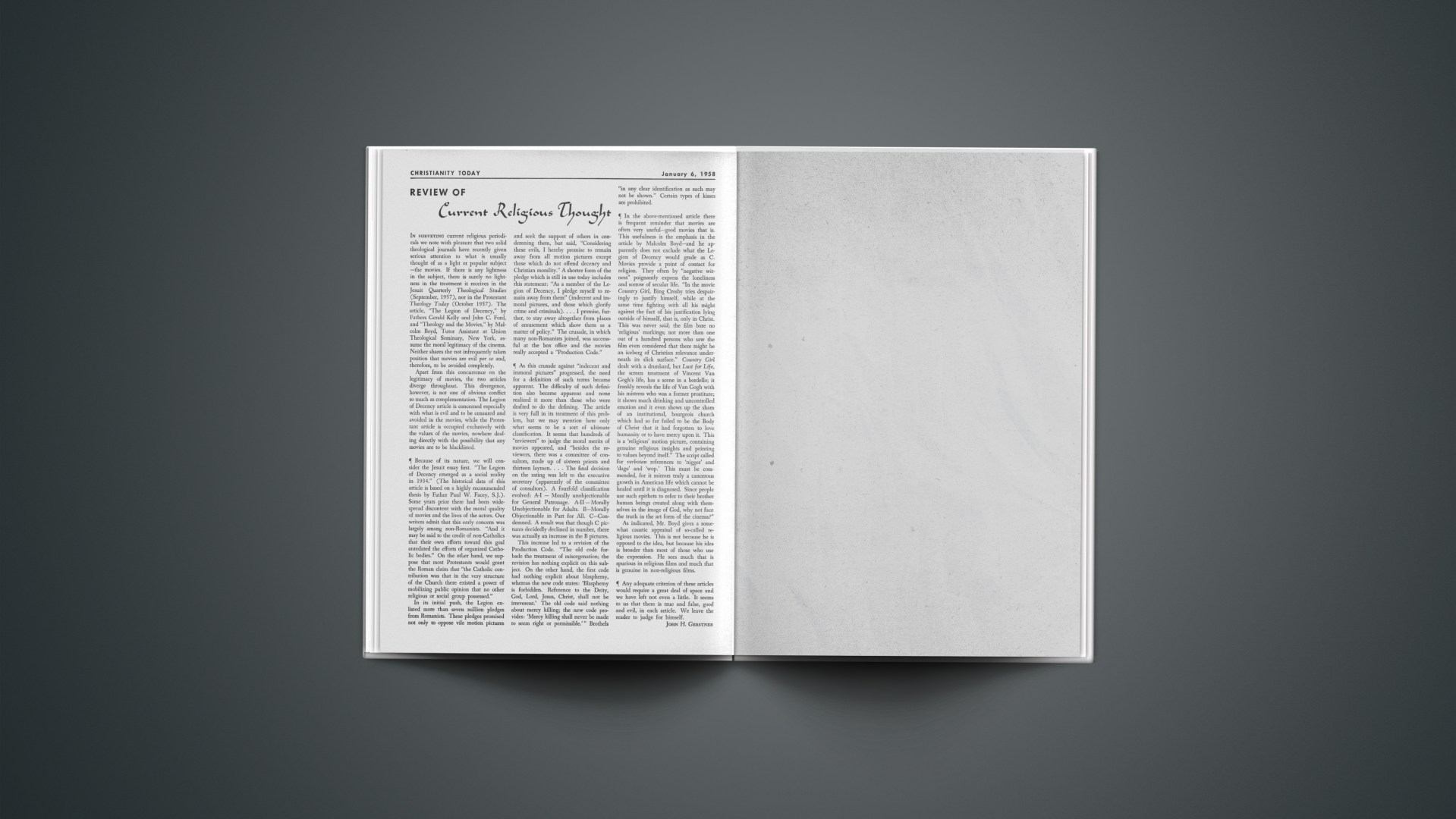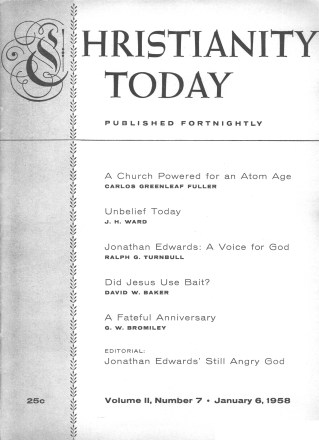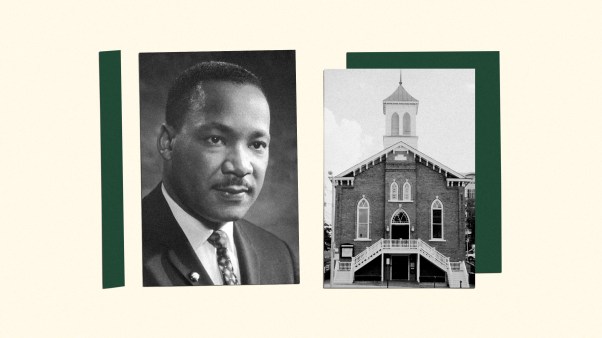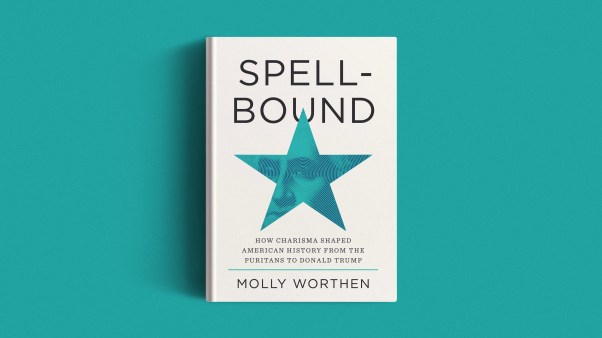IN SURVEYING current religious periodicals we note with pleasure that two solid theological journals have recently given serious attention to what is usually thought of as a light or popular subject—the movies. If there is any lightness in the subject, there is surely no lightness in the treatment it receives in the Jesuit Quarterly Theological Studies (September, 1957), nor in the Protestant Theology Today (October 1957). The article, “The Legion of Decency,” by Fathers Gerald Kelly and John C. Ford, and “Theology and the Movies,” by Malcolm Boyd, Tutor Assistant at Union Theological Seminary, New York, assume the moral legitimacy of the cinema. Neither shares the not infrequently taken position that movies are evil per se and, therefore, to be avoided completely.
Apart from this concurrence on the legitimacy of movies, the two articles diverge throughout. This divergence, however, is not one of obvious conflict so much as complementation. The Legion of Decency article is concerned especially with what is evil and to be censured and avoided in the movies, while the Protestant article is occupied exclusively with the values of the movies, nowhere dealing directly with the possibility that any movies are to be blacklisted.
Because of its nature, we will consider the Jesuit essay first. “The Legion of Decency emerged as a social reality in 1934.” (The historical data of this article is based on a highly recommended thesis by Father Paul W. Facey, S.J.). Some years prior there had been widespread discontent with the moral quality of movies and the lives of the actors. Our writers admit that this early concern was largely among non-Romanists. “And it may be said to the credit of non-Catholics that their own efforts toward this goal antedated the efforts of organized Catholic bodies.” On the other hand, we suppose that most Protestants would grant the Roman claim that “the Catholic contribution was that in the very structure of the Church there existed a power of mobilizing public opinion that no other religious or social group possessed.”
In its initial push, the Legion enlisted more than seven million pledges from Romanists. These pledges promised not only to oppose vile motion pictures and seek the support of others in condemning them, but said, “Considering these evils, I hereby promise to remain away from all motion pictures except those which do not offend decency and Christian morality.” A shorter form of the pledge which is still in use today includes this statement: “As a member of the Legion of Decency, I pledge myself to remain away from them” (indecent and immoral pictures, and those which glorify crime and criminals).… I promise, further, to stay away altogether from places of amusement which show them as a matter of policy.” The crusade, in which many non-Romanists joined, was successful at the box office and the movies really accepted a “Production Code.”
As this crusade against “indecent and immoral pictures” progressed, the need for a definition of such terms became apparent. The difficulty of such definition also became apparent and none realized it more than those who were drafted to do the defining. The article is very full in its treatment of this problem, but we may mention here only what seems to be a sort of ultimate classification. It seems that hundreds of “reviewers” to judge the moral merits of movies appeared, and “besides the reviewers, there was a committee of consultors, made up of sixteen priests and thirteen laymen.… The final decision on the rating was left to the executive secretary (apparently of the committee of consultors). A fourfold classification evolved: A-I—Morally unobjectionable for General Patronage. A-II—Morally Unobjectionable for Adults. B—Morally Objectionable in Part for All. C—Condemned. A result was that though C pictures decidedly declined in number, there was actually an increase in the B pictures.
This increase led to a revision of the Production Code. “The old code forbade the treatment of miscegenation; the revision has nothing explicit on this subject. On the other hand, the first code had nothing explicit about blasphemy, whereas the new code states: ‘Blasphemy is forbidden. Reference to the Deity, God, Lord, Jesus, Christ, shall not be irreverent.’ The old code said nothing about mercy killing; the new code provides: ‘Mercy killing shall never be made to seem right or permissible.’ ” Brothels “in any clear identification as such may not be shown.” Certain types of kisses are prohibited.
In the above-mentioned article there is frequent reminder that movies are often very useful—good movies that is. This usefulness is the emphasis in the article by Malcolm Boyd—and he apparently does not exclude what the Legion of Decency would grade as C. Movies provide a point of contact for religion. They often by “negative witness” poignantly express the loneliness and sorrow of secular life. “In the movie Country Girl, Bing Crosby tries despairingly to justify himself, while at the same time fighting with all his might against the fact of his justification lying outside of himself, that is, only in Christ. This was never said; the film bore no ‘religious’ markings; not more than one out of a hundred persons who saw the film even considered that there might be an iceberg of Christian relevance underneath its slick surface.” Country Girl dealt with a drunkard, but Lust for Life, the screen treatment of Vincent Van Gogh’s life, has a scene in a bordello; it frankly reveals the life of Van Gogh with his mistress who was a former prostitute; it shows much drinking and uncontrolled emotion and it even shows up the sham of an institutional, bourgeois church which had so far failed to be the Body of Christ that it had forgotten to love humanity or to have mercy upon it. This is a ‘religious’ motion picture, containing genuine religious insights and pointing to values beyond itself.” The script called for verboten references to ‘nigger’ and ‘dago’ and ‘wop.’ This must be commended, for it mirrors truly a cancerous growth in American life which cannot be healed until it is diagnosed. Since people use such epithets to refer to their brother human beings created along with themselves in the image of God, why not face the truth in the art form of the cinema?”
As indicated, Mr. Boyd gives a somewhat caustic appraisal of so-called religious movies. This is not because he is opposed to the idea, but because his idea is broader than most of those who use the expression. He sees much that is spurious in religious films and much that is genuine in non-religious films.
Any adequate criterion of these articles would require a great deal of space and we have left not even a little. It seems to us that there is true and false, good and evil, in each article. We leave the reader to judge for himself.










